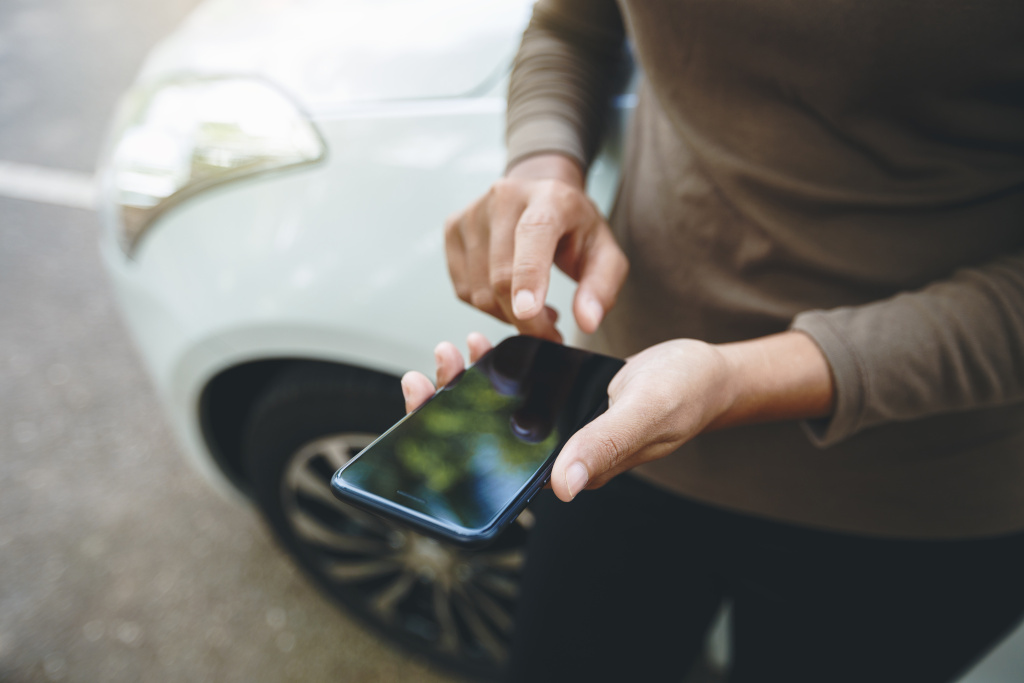The word “telematics” was first used by French researchers in the late 1970s. They wrote and presented a report on the “computerization of society.” Specifically, they mentioned the transfer of information by telecommunications.
Telematics Insurance Basics
In today’s language, when most people talk about telematics, it’s usually about cars.
Vehicle telematics can include:
- GPS
- Integrated hands-free mobile phone
- Wireless safety communication
- Automatic driving assistance systems
- Vehicle tracking
For this article, when we discuss telematics, we’ll be referring to it as usage-based auto insurance.
How Telematics Works
Usage-based auto insurance (UBI) is when an app or other device directly monitors a driver’s behavior and sends it to the company via telecommunications. The insurer reviews the driver’s performance and determines their risk of having an accident and/or filing a claim.
Lower risk equals a lower insurance premium, often in the form of a safe driver discount. Drive poorly and you’ll end up paying more.
Insurers also use telematics for “pay by the mile” auto insurance. With this type of coverage, companies base their premiums on miles driven. This is a fantastic, low-cost option for a vehicle that spends more time in the garage than on the street.
Insurance Companies With Telematics Programs
Several major insurers offer telematics programs to customers, including:
- Allstate
- American Family
- Farmers
- GEICO
- Liberty Mutual
- Nationwide
- Progressive
- State Farm
- Travelers
- USAA
Data Collection
Auto insurance companies use tracking devices to observe driving performance and the number of miles you drive. These observations can last from four weeks up to six months. And some providers say they plan on keeping this data for at least ten years. But for most auto insurers, there’s very little public information on their data retention policies.
Insurers collect driving data by using a mobile app or a device that you plug into your car. The type of data can include:
- Number of miles you drive
- Average speed
- Acceleration, braking, cornering, and sudden stops
- Time of day
- Airbag deployment
- Phone use
App vs. Device
The main use of phone apps is to monitor a driver’s safety performance. Devices that plug into your car’s OBD port are for “pay as you go” or “pay by the mile” insurance. Both have their pluses and minuses.
Phone monitoring is the easiest to use. No installation of hardware. And no unsightly cables or devices. However, it’s the least reliable method for gathering telematic data. Mainly because people rarely put phones in the same place every time they drive. This can affect the calibration and orientation sensors the phone and its applications use.
Along with ease of use, phone apps allow drivers to review their trips. And we highly recommend that you do. Companion mobile apps map your drives in detail.
Apps log risky events like hard braking and fast starts. By raising your awareness, these apps can help bring attention to driving more safely. Which could lead to a lower premium.
Additionally, reviewing your trips is a great way to ensure the app’s accuracy. App-only telematics programs can’t always tell if you’re driving a car or riding in someone else’s. It may ding you for shoddy driving that isn’t yours.
Take care if you hand your phone to someone else. The app may think you’re texting and driving, even if you’re a passenger or if you hand your phone to a passenger to use.
Most programs will allow you to edit a drive or dispute a mistake. You may complete minor adjustments in the app itself. But some more complicated disputes require a call to customer service.
Devices plug into your car’s diagnostic port. It’s easy to install, anyone can do it. Data from this method is much more accurate than from phone applications. But doing it yourself may mean they aren’t always secured properly and can get knocked out of the port.
Not Legal in All States
Geolocation and tracking have become a source of high anxiety among privacy experts. The laws haven’t kept up with technology when it comes to telematics.
There are different types of laws that address tracking someone without their knowledge. And hardly any that talk about tracking a car or person on purpose.
Each state has its own set of privacy laws. In California, when setting prices, insurers can’t collect any telematics variable beyond mileage. Other states may also disapprove of specific providers’ programs. In North Carolina, for instance, customers can’t use Progressive’s Snapshot and Liberty Mutual’s RightTrack.
No national law covers auto insurance, telematics, and privacy. We recommend researching your state’s specific privacy laws. Most state privacy laws are under the jurisdiction of a state’s attorney general. Or you can do an online search using Google. Just type in “(state name) state privacy laws.”
Will Telematics Raise Your Rates?
Most auto insurers swear up and down rates won’t go up. They pledge they’ll only use the data for calculating discounts on their premiums. We recommend reading the fine print.
Car insurance company websites are a great source of detailed information. As of the publishing of this article, several companies say on their sites that risky driving won’t lead to higher premiums. Those companies include American Family, Farmers, Liberty Mutual, Nationwide, State Farm, and USAA.
And a few companies said they will raise your premiums if you drive poorly while taking part in their telematics programs. These companies are Allstate, GEICO, Progressive, and Travelers, depending on which state you live in.
Unfortunately, not all car insurers are upfront about the details of their telematics programs. There appears to be a real lack of transparency. Many of the details are unavailable in the product and policy materials created for consumers.
Some of the data providers collect also may inadvertently harm certain groups of consumers. Consider the gathering of “time of day” driving data. It wouldn’t be a stretch to imagine auto insurance companies giving a discount for driving only during daylight hours.
There are other possible consequences. We wonder if insurance companies might cancel or non-renew the worst drivers.
How Much You Can Save
All but two of the ten car insurance companies offer a small discount when you sign up. Additional savings are calculated after completing the initial telematics data gathering and evaluation.
| Company | Automatic Savings | Max Savings |
|---|---|---|
| Allstate | 10% | 40% |
| American Family | 10% | 20% |
| Farmers | 5% | 30% |
| GEICO | 15% | 25% |
| Liberty Mutual | 5% | 30% |
| Nationwide | 5% | 15% |
| Progressive | N/A | Up to $156 per year |
| State Farm | 10% | 30% |
| Travelers | N/A | 30% |
| USAA | 10% | 30% |
Most auto insurance companies will grant a telematics discount for the life of the policy. So, once your evaluation period is complete, your new rate will stay the same as long as you remain with the same insurer.
Is a Telematics-Based Insurance Policy Right for You?
It all depends on your driving behavior. For those struggling with rising premium costs, a telematics program could offer substantial savings.
Folks who may benefit from a “pay as you go” policy include:
- Low mileage drivers – less than 35 miles a day
- Retirees
- People who use public transportation daily
- Employees who work from home
A behavior-based telematics program could help:
- Those who live in high-crime areas
- People with low credit scores
- Young drivers
- Drivers who want to improve and welcome feedback
To achieve savings, you’ll need to be OK with broad surveillance and the risk that your information could be used for things other than reducing prices. If this makes you too uncomfortable, sticking with a more traditional policy would be the way to go.
Other groups who should stay away from telematics programs include:
- Those who drive during rush hour or late at night
- High mileage drivers – over 12,000 miles a year
- Mobile phone addicts
- Hard brakers, those who turn corners at high speeds, and folks who think speed limits are mere suggestions
Bottom line: it’s personal.
Tips for Choosing the Right Telematics Program
You’ve read the article and determined auto insurance telematics is the way to go. Now what? Here’s a list of items to consider when selecting a program:
- Compare data points that insurers collect – if you drive mostly at night, avoid programs using that data.
- Do they offer a discount just for signing up?
- What’s the maximum savings possible?
- Will they provide trip reports and feedback on your driving behavior?
- How long is the data collection period?
- How long will my telematics discount be in effect?
We also suggest reading our article on the best insurance telematics programs. We’ve ranked several leading insurers on both the quality of their programs and how much they can save you.
Frequently Asked Questions
Is telematics worth it?
This is a complicated and personal question. The answer depends on many factors, including but not limited to your tolerance for a perceived invasion of privacy. If this doesn’t bother you, telematics could significantly lower your insurance rates.
Is telematics accurate?
It depends. Telematics relies on you, your car, your mobile phone, and the auto insurer. Look for a phone app that records trip data. That way you can review and double-check for accuracy.
Can telematics increase your premium?
Yes. Multiple car insurance companies that offer telematics programs state they “could” use your driving data to increase premiums.
Does telematics increase your chance of policy cancellation?
Insurance providers can cancel policies or choose not to renew at the end of a policy term. Non-renewal can occur after multiple accidents or filing too many claims.
What’s the difference between usage-based and pay-per-mile coverage?
Usage-based policies are based on data about how a driver behaves. An app on the driver’s cell phone looks at the time of day they drive and how hard braking and cornering were done. Pay-per-mile insurance, on the other hand, is a form of coverage where you’re billed based on how many miles you drive.
Can I get a good driver discount without participating in a usage-based program?
Yes. Most car insurance companies award good driver discounts after a set period, usually after two or three years of zero accidents and tickets.
What other ways can lower rates for being a safe driver?
Driving a vehicle with safety features can get you the anti-lock brakes (ABS) or the anti-theft device discount. Other safety equipment may qualify for more discounts. Some auto insurance companies offer a savings for certain professions, like teachers. Good students can qualify for lower rates as well.
Terms
- Telematics program – the integration of IT with telecommunications, especially with cars
- Telematics system – tracks and gathers information such as vehicle location, driver behavior, engine performance, and vehicle activity
- Telematics device – plugs into the car and works with a phone application to record trips
- Telematics software (apps) – resides on mobile phones, and can be for data collection and trip reviews
- Pay as you drive – premium based on monitoring your driving behavior and car. Metrics monitored and sent to the insurer include driving time of day, how hard you brake, the sharpness of turns, and how quickly you accelerate
- Usage-based car insurance (UBI) – individualized insurance based on telematic analysis of drivers. Each driver receives a rate based on their driving, factoring in the type of road users (freeway or urban), braking, and cornering


